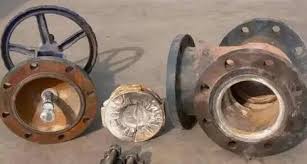How To Solve Valve Corrosion

Why Valve Corrosion Appears?
- Chemical Exposure: Exposure to corrosive fluids or gases can lead to chemical corrosion of valve materials. Substances such as acids, alkalis, salts, and other corrosive chemicals can react with valve components, causing degradation and corrosion over time.
- Moisture: Moisture or water vapor in the system can promote corrosion, especially in environments with high humidity or condensation. Water can react with metal surfaces, leading to the formation of rust and corrosion.
- Oxygen: Oxygen in the air can react with metal surfaces, particularly in the presence of moisture, leading to oxidation and corrosion. This process, known as atmospheric corrosion, can weaken valve materials over time.
- Galvanic Corrosion: When two different metals are in contact in the presence of an electrolyte (such as water), an electrochemical reaction can occur, leading to galvanic corrosion. This can happen if dissimilar metals are used in valve construction or if the valve is installed in a system with mixed metal components.
- High Temperatures: Elevated temperatures can accelerate corrosion processes, especially in the presence of corrosive substances. High temperatures can increase the rate of chemical reactions and promote oxidation and corrosion of valve materials.
How To Solve Valve Corrosion?
- Material Selection: Choose corrosion-resistant materials for valve construction, such as stainless steel, bronze, or alloys like Monel or Hastelloy, depending on the specific application and the corrosive environment.
- Coatings and Linings: Apply corrosion-resistant coatings or linings to valve surfaces to provide an additional barrier against corrosive substances. Options include epoxy coatings, fluoropolymer linings, or ceramic coatings.
- Cathodic Protection: Implement cathodic protection methods, such as sacrificial anode systems or impressed current systems, to protect valves from galvanic corrosion by controlling the flow of electrical current.
- Corrosion Inhibitors: Add corrosion inhibitors to the fluid or gas being conveyed through the system to mitigate corrosion of valve materials. These inhibitors can form a protective film on metal surfaces, reducing the rate of corrosion.
- Regular Maintenance: Perform routine inspection and maintenance of valves to detect and address any signs of corrosion early. This may include cleaning, lubrication, and replacement of corroded components as necessary.
- Proper Installation: Ensure valves are installed correctly and in accordance with manufacturer recommendations. Proper installation can help minimize exposure to corrosive elements and prevent premature corrosion.
- Environmental Controls: Control environmental factors such as temperature, humidity, and exposure to corrosive substances to reduce the likelihood of corrosion. Implement measures such as ventilation, dehumidification, or corrosion-resistant enclosures as needed.
- Fluid Monitoring: Monitor the composition and quality of fluids or gases flowing through the system to detect any changes that may contribute to corrosion. Regular testing and analysis can help identify potential corrosion issues early.

how to repair Rusty valve?
- Assessment: Begin by assessing the extent of rust damage on the valve. Determine if the rust is superficial or if it has caused significant structural damage to the valve components.
- Cleaning: Use a wire brush, sandpaper, or abrasive pads to remove surface rust from the valve. Scrub the affected areas thoroughly until the rust is removed, and the metal surface is clean and smooth.
- Decontamination: If the valve was exposed to corrosive substances, thoroughly clean and decontaminate the valve to remove any remaining traces of chemicals or contaminants that may contribute to further corrosion.
- Rust Converter: Apply a rust converter solution to the cleaned metal surface. Rust converters chemically convert rust into a stable compound that can be painted over. Follow the manufacturer’s instructions for application and drying times.
- Priming: Apply a rust-inhibiting primer to the treated metal surface. The primer will create a protective barrier against moisture and further corrosion. Choose a primer suitable for the type of metal and intended application.
- Painting: Once the primer is dry, apply a coat of rust-resistant paint to the valve. Choose a paint specifically formulated for metal surfaces and resistant to corrosion. Apply multiple coats as needed, following the manufacturer’s instructions for drying times between coats.
- Sealing: If the valve has moving parts or seals, inspect them for damage or wear. Replace any damaged seals or components to ensure proper functionality and prevent leaks.
- Regular Maintenance: After repairing the rusty valve, implement a regular maintenance schedule to inspect and clean the valve periodically. Keep the valve protected from moisture and corrosive substances to prevent rust recurrence.
